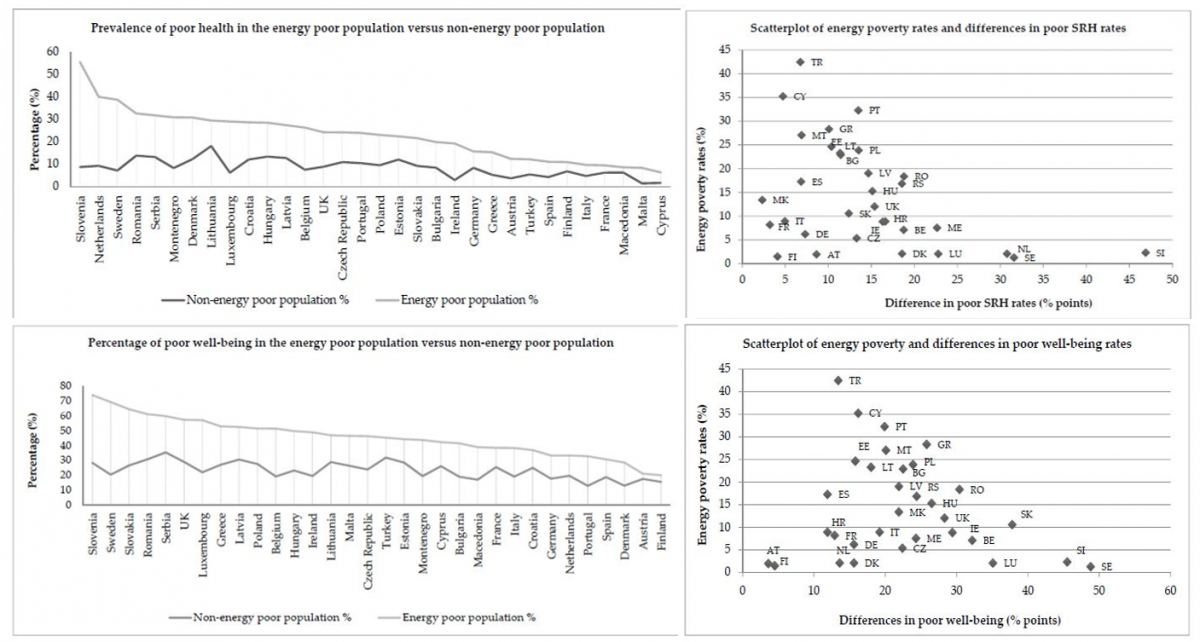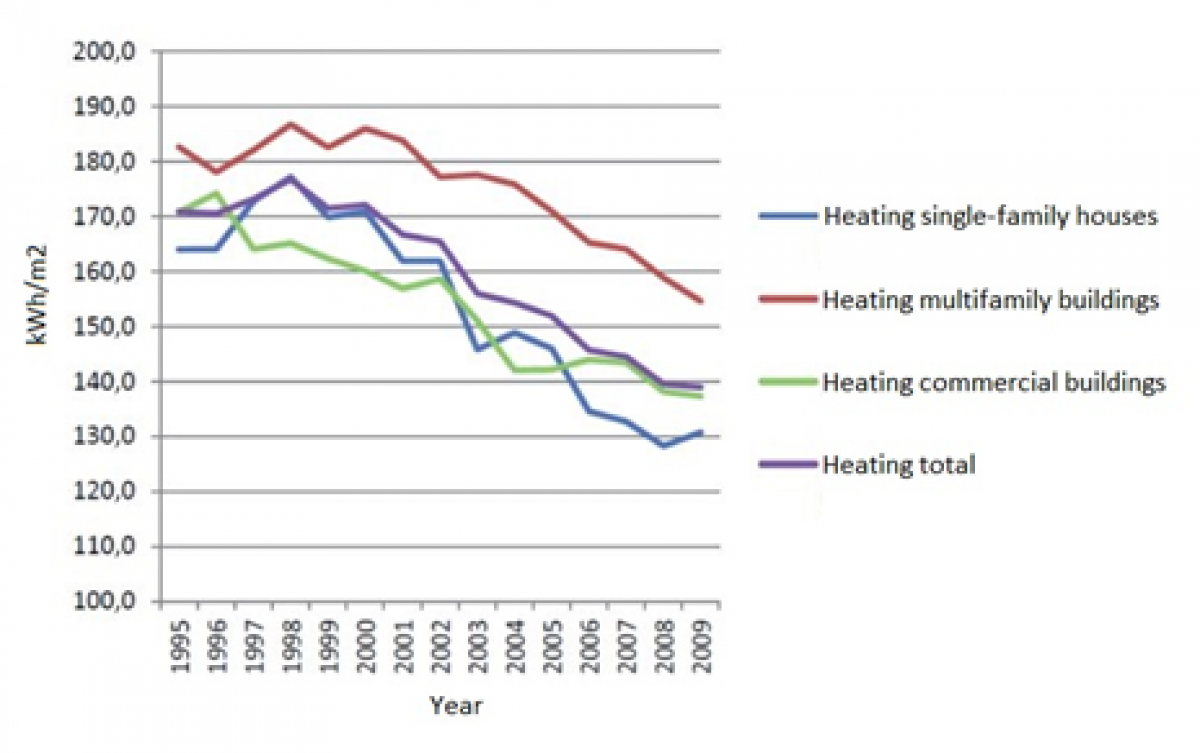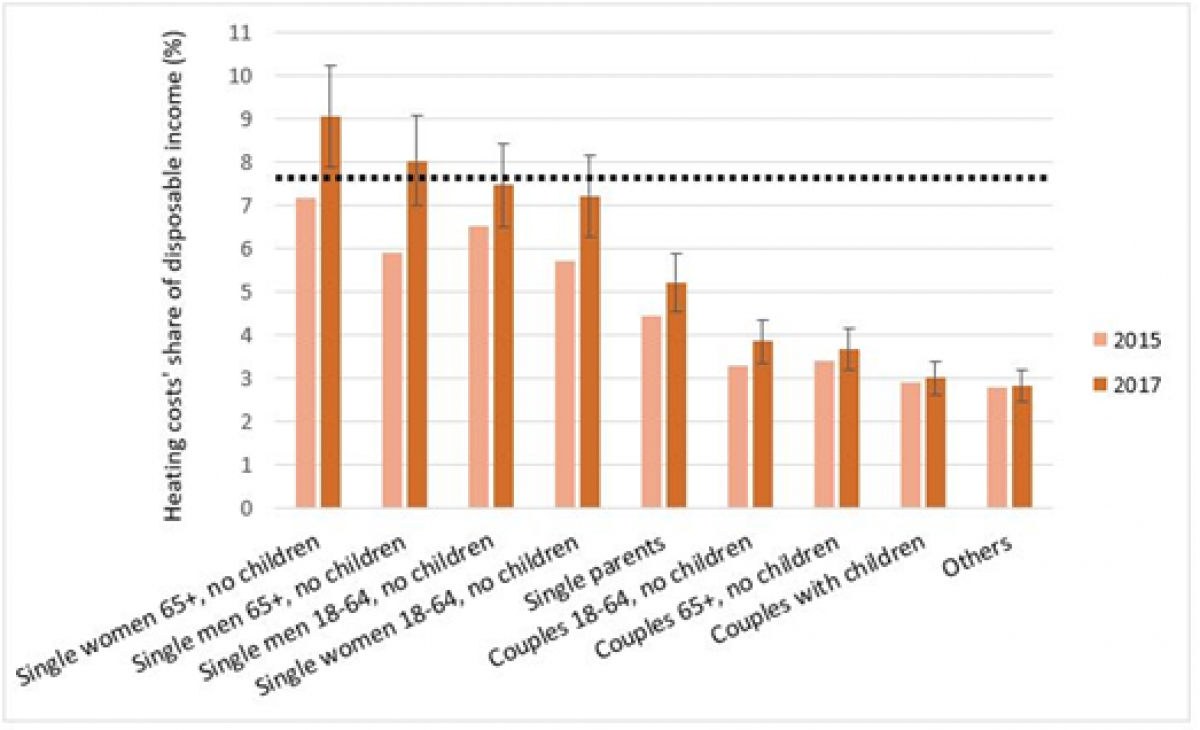von Platten, J. (2021) Energy poverty in Sweden. EP-pedia, ENGAGER COST Action.
Policy perspective on energy poverty
In the Swedish policy landscape, there is a reluctance towards using the term energy poverty as authorities and politicians do not consider this issue to be relevant in the Swedish context. The reason for this is briefly stated in the Swedish national Long-Term Renovation Strategy, in which the EU commission requests a description of the status on energy poverty in Sweden:
“Sweden does not differentiate energy poverty from poverty in general, and the term energy poverty is therefore not used. The issue is handled within the social politics and there are no measures specifically targeting energy poverty.” (Ministry of Infrastructure, 2020)
This rhetoric is consistent in all policy documents mentioning energy poverty. To the author’s knowledge, the first, and most comprehensive, public document on energy poverty was written in 2015 by the Swedish Defence Research Agency (FOI). FOI has a long tradition of studying national matters of energy and security and owing to the increased recognition of energy poverty within the EU, FOI investigated what energy poverty could entail in a Swedish context on behalf of the Swedish Energy Agency (FOI, 2015). According to the report, energy poverty as defined in many other EU member states was not thought to be present in Sweden owing to the strong social support system, covering costs for adequate warmth and other household- and energy-related demands, including accommodation, for low-income and other vulnerable groups (Johansson et al., 2015). More so, there are regulations regarding energy disconnections where energy suppliers are obliged to contact social services before disconnecting energy supply to customers who have arrears on their energy bills.
FOI also stress the strong correlation between protecting vulnerable energy consumers and securing long- and short-term energy supply as severe situations of energy deficit, causing prices to increase drastically, would disproportionally burden vulnerable households. Consequently, they argue that a strategy for securing energy supply is an important measure to limit potential energy poverty and protect vulnerable customers. This is a balancing act between building more capacity in the energy infrastructure, which will lead to generally higher energy prices for households, but fewer price peaks caused by limited supply, and relying on demand-side flexibility, which might exclude vulnerable households from demanding energy at times when demand is exceeding supply (Johansson et al., 2015). It is clear that both generally higher energy prices as well as particularly high energy prices at peak demand might worsen the situation for households that are vulnerable to energy poverty – either by limiting their overall energy use or by restricting their energy use at certain times. Yet, in an ongoing project on how to regulate tariffs on the electric grid for optimised grid capacity led by the Swedish Energy Markets Inspectorate, little recognition is directed towards vulnerable households, despite preliminary analyses showing that changed tariffs are likely to significantly increase the electricity costs for residents living in apartments (Carlsson et al., 2020) – the part of the housing stock where the highest share of low-income earners are found.
Research perspective on energy poverty
As Swedish authorities have not recognised energy poverty as an issue among Swedish households, research on energy poverty is close to non-existent. Although there is research in Sweden on how buildings’ energy use and indoor environment affect the health and well-being of residents, such research has never been conducted within the theoretical framework of energy poverty. For studies on indicators and characterisation of energy poverty in a Swedish context, it is thus necessary to turn to research that has been conducted outside of Sweden.
According to analyses by the EU Energy Poverty Observatory on Eurostat survey data, the share of households unable to keep their home adequately warm in Sweden has been estimated to 2.3% in 2018 (EPOV, 2020). While this confirms and supports the low level of consideration regarding energy poverty in Sweden, it also reveals that there are households in Sweden who suggestibly are energy poor without being recognised as such. Although the social support system is likely to facilitate the situation for many energy-vulnerable households, the coping mechanisms and social implications among households not receiving support remain an overlooked area of research in the Swedish context. As knowledge on the situation of energy poor or energy vulnerable households in Sweden is very limited, there is a risk that many households are carrying unrecognised burdens that lack targeted remedies.
More so, a low prevalence of the type of energy poverty that is recognised in other countries does not imply lower burdens for the affected households, nor does it exclude the prevalence of context-specific forms of energy poverty in Sweden. In terms of burdens from energy poverty, research has shown that the greatest prevalence of poor health in energy poor populations is found in countries with low occurrence of energy poverty; generally coinciding with low levels of economic inequality (Thomson et al., 2017). This can be seen in Figure 1(a-d), where poor self-reported health status (SRH) and poor emotional well-being in energy poor populations are the highest in countries with low prevalence of energy poverty, such as Sweden, Slovenia and the Netherlands. These results indicate that Sweden, a country with high levels of equality and income, should not be assumed to be spared from severe impacts from energy poverty; although chances are the low prevalence of energy poverty makes the overlap between energy poor households and households in extreme poverty rather large.
In terms of context-specific forms of energy poverty, it has been suggested that the relatively frequent power cuts in some parts of Sweden, the north in particular (Breivik & Kamb, 2017), can be interpreted as a form of energy poverty (BUILD2LC, 2017). In anticipation of frequent power cuts, many households keep emergency kits (BUILD2LC, 2017) and are incentivised to add additional insulation in order to keep their home warm for longer during power cuts (Breivik & Kamb, 2017). This relates to FOI’s discussion on the importance of secure energy supply to limit vulnerability to energy poverty.

Figure 1(a-d). Line graphs showing the prevalence of (a) poor SRH rates and (c) poor emotional well-being among the energy poor and non-energy poor populations across 32 European countries, and scatterplots of energy poverty rates and differences in (b) poor SRH rates and (d) poor emotional well-being between energy poor and non-energy poor populations across 32 European countries (Thomson et al., 2017).
Characteristics of the housing stock and vulnerabilities to energy poverty
Besides a strong social support system, two of the main reasons why energy poverty has remained limited in Sweden are the comparatively well-insulated and energy efficient housing stock and the use of “warm rent” in the multifamily building stock. Warm rent means that heating costs are included in the rent as a fixed component that is independent of households’ actual energy use for heating. Consequently, heating costs are uncontrollable as well as invisible for households living in multifamily buildings, and this is by many considered one of the main reasons as to why it is possible to claim that there is no energy poverty in the Swedish multifamily building stock (Sveriges Allmännytta, 2021).
The use of warm rent is predominantly endorsed within the Swedish housing industry as it puts the economic incentives for improved energy performance of the building on the landlord, who, unlike the tenants, is in a position to make energy efficiency investments in the building (Nordstrand et al., 2019). Many consider the potential for energy savings from such investments in energy retrofits and energy efficiency measures to be greater than the energy savings that would be achieved from shifting the economic incentives to reduce energy use onto the tenants (Nordstrand et al., 2019).
However, incentivising energy savings in tenants’ day-to-day energy-related behaviour, such as lowered indoor temperatures and reduced manual ventilation through opening of windows, is an important part of the EUs strategy for reduced energy use in the building stock. Consequently, directive 2012/27/EU on Energy Efficiency requires energy for heating to be metered and billed individually for every household, and the EU has requested changes in Swedish regulation on billing and metering of energy for heating for many years. After a long time of Sweden pushing back and arguing for the energy performance benefits of the current system with warm rents, an agreement was finally settled between Sweden and the EU commission in 2019 deciding that individual metering and billing of energy for heating should be required in the worst-performing multifamily buildings. The regulation will be enforced in July 2021.
Almost exclusively, it is in relation to this policy that energy poverty has been discussed in the Swedish public debate, as many stakeholders feared that introducing individual metering and billing of energy for heating would also introduce energy poverty in the Swedish multifamily building stock (Hyresgästföreningen, 2019; Nordstrand et al., 2019; Wiederholm et al., 2020). Although there are other factors still limiting energy poverty, the new regulation is likely to create a new group of households vulnerable to the state of energy poverty in Sweden. The regulation demands individual metering and billing of energy for heating in buildings where energy performance is particularly low, i.e. where energy demand is particularly high, and where we also find an over-representation of low-income households (von Platten et al., 2020). This means that the warm rent that historically has acted as a protector against energy poverty will be removed in the part of the multifamily building stock where vulnerability to energy poverty is among the highest. The effects of this new regulation will have to be evaluated further on. Figure 2 shows the income distribution of residents affected by the new regulation, and it can be seen that low-income households are disproportionally affected in general, and that the lowest income decile is particularly affected. The figure also shows information regarding the average living space per capita (size of circles) and the average energy use per capita (colour of circles), limited to energy use for heating, domestic hot water and ventilation. It can thus be seen that the low-income households being put at a new risk for energy poverty in the name of reducing energy use are households living on a relatively small area per person and having relatively low per capita energy use.

Figure 2. Number of residents in different income deciles living in buildings affected by the new regulation regarding individual metering and billing of energy for heating (von Platten et al., 2020).
In the single-family housing stock, where 52% of the Swedish population resides (SCB, 2019), incomes are generally higher than in the multifamily building stock and energy performance tends to be higher as well (IVA, 2012) partly owing to a substantial deployment of heat pumps over the past decades. The energy performance of single-family houses, multifamily buildings and commercial buildings can be seen in Figure 3. Had it not been for warm rent still dominating in the multifamily building stock, a general conclusion could thus have been that the vulnerability to energy poverty would be higher in the multifamily building stock than in the single-family housing stock. Nevertheless, the strong protection against energy poverty that still remains in the multifamily building stock makes the general vulnerability to energy poverty higher in the single-family housing stock.

Figure 3. Development of energy use for heating per square meter in different building categories in Sweden between 1995-2009 (IVA, 2012).
Increasing energy prices since the start of the 21st century in combination with increasing economic inequalities and an ageing population are factors that have increased the share of households that are vulnerable to energy poverty in the single-family housing stock. While the increasing energy prices are being debated, the increasing risk for energy poverty is rarely recognised, with very few exceptions (Aktuell Hållbarhet, 2014).
Although insufficient to capture the complexity of energy poverty, analysis of the share of heating costs of disposable income in different household types is shown in Figure 4. The figure is based on deductions of official statistics and should primarily be viewed as indicative results of the vulnerability to energy poverty among the household types (von Platten, 2019). Using the double median, a preliminary limit for energy poverty in Swedish single-family houses is set to 7.6% of disposable income being spent on energy for heating, as the median in 2017 was 3.8% (von Platten, 2019). This limit is shown by the dotted line in Figure 4. It can be seen that based on this indicator of energy poverty, it is primarily single households of persons over 65 years old that appear to be particularly vulnerable to energy poverty, although single households aged 18-64 years old are close to the limit as well. Further division of single parents based on age and gender shows that single mothers aged 18-29 years old surpass the limit as well (von Platten, 2019).
As it is well known from the literature that elderly, single households and single parents tend to be vulnerable to energy poverty, the most prominent result from Figure 4 is perhaps the high increase in heating costs’ share of disposable income among single households between 2015 and 2017, and particularly among single households aged 65 and above. This development confirms that vulnerability to energy poverty is increasing among certain household groups in Sweden.

Figure 4. Heating costs’ share of disposable income in different household types. The dotted line marks the double median of heating costs’ share of disposable income in Sweden (von Platten, 2019).
Future challenges that may cause new vulnerabilities to energy poverty
While energy poverty might be understudied and perhaps underestimated by Swedish authorities, it remains a fact that the prevalence of energy poverty is relatively low in Sweden when compared to other European countries. Nevertheless, changes in climate and energy systems are likely to aggravate existing energy-related inequalities and create unforeseen issues connected to energy poverty. The phase-out of nuclear power along with development of intermittent energy production will continue to increase the reliance on demand-side flexibility, which inevitably will raise questions of who is able to use energy and when. Indeed, there is a need for more research mapping the characteristics of current and future vulnerabilities to energy poverty in Sweden.
Aktuell Hållbarhet. (2014). ”Svenska hushåll nära energifattigdom”. https://www.aktuellhallbarhet.se/miljo/energi/svenska-hushall-nara-energifattigdom/
Breivik, M., & Kamb, A. (2017). Sverige har minst energifattigdom i Europa – men utmaningar med energiförsörjning https://www.regionjh.se/nyheter/pressmeddelanden/gamlapressmeddelanden3ar/gamlapressmeddelanden/sverigeharminstenergifattigdomieuropamenutmaningarmedenergiforsorjning.5.411f518f15cadaa5c0d6a69c.html
BUILD2LC. (2017). New Energy Culture, Citizen Involvement and energy poverty: Topic Report - Gloucester, 30th September 2017. https://www.interregeurope.eu/fileadmin/user_upload/tx_tevprojects/library/file_1543312812.pdf
Carlsson, J., Lundgren, J., Kaplin, S., Widman, M., & Karlsson, T. (2020). Elnätstariffer för ett effektivt nätutnyttjande - Principiella val för utformningen av nättariffer (Ei PM2020:06). https://www.ei.se/sv/Publikationer/Rapporter-och-PM/rapporter-2020/pm-elnatstariffer-for-ett-effektivt-natutnyttjande-principiella-val-for-utformningen-av-nattariffer/
EPOV. (2020). Member State Report Sweden. https://www.energypoverty.eu/sites/default/files/downloads/observatory-documents/20-06/extended_member_state_report_-_sweden.pdf
FOI. (2015). ”FOI studerar energifattigdom”. https://www.foi.se/nyheter-och-press/nyheter/2015-11-04-foi-studerar-energifattigdom.html
Hyresgästföreningen. (2019). Remissvar: Förbättrat genomförande av direktivet om energieffektivitet – Individuell mätning av värme och tappvarmvatten i befintlig bebyggelse. https://www.hyresgastforeningen.se/globalassets/faktabanken/remissvar/2019/forbattrat-genomforande-av-eu-direktivet-om-energieffektivitet---individuell-matning-av-varme-och-tappvarmvatten-i-befintlig-bebyggelse.pdf
IVA. (2012). Energieffektivisering av Sveriges flerbostadshus: Hinder och möjligheter att nå en halverad energianvändning till 2050 (IVA-R 469). IVA. https://www.iva.se/globalassets/rapporter/ett-energieffektivt-samhalle/201206-iva-energieffektivisering-rapport1-f1.pdf
Johansson, B., Jonsson, D. K., Veibäck, E., & Mittermaier, E. (2015). Energifattigdom, försörjningstrygghet och offentligt agerande (FOI-R--4020--SE). FOI. https://www.foi.se/rapportsammanfattning?reportNo=FOI-R--4020--SE
Nordstrand, A., Lennebo, R., Linder, M., Lago, A., & Linde, L. (2019). ”Nobba EU-kraven på våra bostäder”. Svenska Dagbladet. https://www.svd.se/nobba-eu-kraven-pa-vara-bostader
Ministry of Infrastructure. (2020). Sveriges tredje nationella strategi för energieffektiviserande renovering. https://www.regeringen.se/495d4b/contentassets/b6499271ac374526b9aa6f5e944b0472/sveriges-tredje-nationella-strategi-for-energieffektiviserande-renovering.pdf
SCB. (2019). “Swedish residences”. Statistics Sweden https://www.scb.se/hitta-statistik/sverige-i-siffror/manniskorna-i-sverige/boende-i-sverige/
Sveriges Allmännytta. (2021). ”Energy Efficiency”. https://www.sverigesallmannytta.se/in-english/energy-efficiency/
Thomson, H., Snell, C., & Bouzarovski, S. (2017). Health, Well-Being and Energy Poverty in Europe: A Comparative Study of 32 European Countries. International journal of environmental research and public health, 14(6), 584. https://doi.org/10.3390/ijerph14060584
von Platten, J. (2019). Forskningsrapport 4: Energifattigdom i Sverige.
von Platten, J., Mangold, M., & Mjörnell, K. (2020). Energy inequality as a risk in socio-technical energy transitions: The Swedish case of individual metering and billing of energy for heating. IOP Conference Series: Earth and Environmental Science, 588, 032015. https://doi.org/10.1088/1755-1315/588/3/032015
Wiederholm, J., von Platten, J., & Mangold, M. (2020). ”Fattiga kan tvingas välja bort värme”. Svenska Dagbladet. https://www.svd.se/fattiga-kan-tvingas-valja-bort-varme
